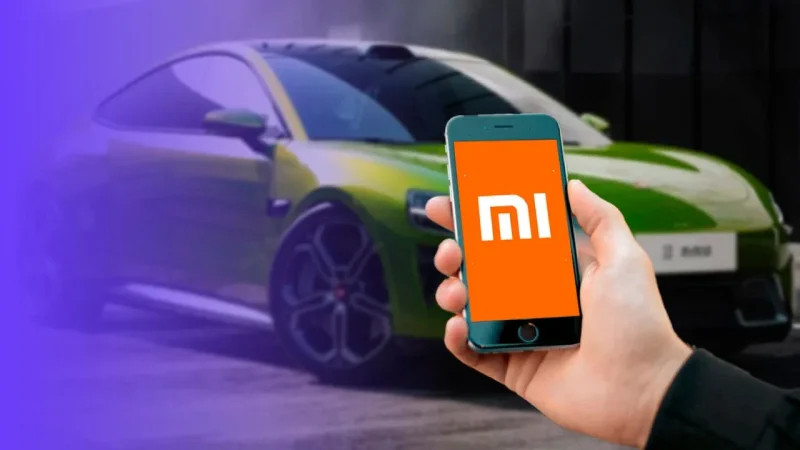In a launch event held at the China National Convention Centre, thousands of people watched Xiaomi (OTCMKTS: XIACF) unveil its first-ever electric vehicle, the Xiaomi SU7.
The smartphone company’s billionaire CEO and co-founder, Lei Jun, boldly declared on stage a few days ago that the SU7 is as good as Porsche (OTCMKTS: POAHF) and Tesla (NASDAQ: TSLA) models when it comes to performance and technology. That is a very bold claim by a very bold man.
The SU7’s debut comes at a time when the Chinese EV market is getting increasingly competitive with price cuts and new technologies, making this a huge gamble for Xiaomi. Will the SU7 be a Tesla killer, or will it crash and take the whole company down with it?
The SU7
Xiaomi’s CEO, Lei Jun, unveiled the company’s first electric vehicle on December 28, which is set to release next year. In the launch event, Lei declared ambitions to become a top global automaker in the next 15 to 20 years, while producing cars that can compete against Tesla and Porsche.
The sedan, dubbed the SU7 for Speed Ultra, is a highly anticipated model that is expected to make the most of its shared operating system with the company’s popular phones.
Lei believes that his company, which is the third largest smartphone manufacturer in the world, can change the transport sector, as it did with smartphones a decade ago. This entrance into the EV market is a $10 billion wager by Lei, and also his final entrepreneurial bet, after a long time being a prolific venture investor.
The new EV will come in two versions, the SU7 and the SU7 Max, with batteries that will be sourced from Chinese market leaders Contemporary Amperex Technology (SHE: 300750) and BYD (OTCMKTS: BYDDF), depending on whether the car is the single-motor rear-wheel-drive SU7 or the dual-motor all-wheel-drive SU7 Max.
The Challenges
Xiaomi announced its plans to start producing EVs back in 2021, when it was a simpler time for the Chinese EV market. But, now the country’s regulatory landscape and competition in the industry have changed drastically, and Xiaomi will have to navigate these challenges.
Starting with the regulatory challenges, Beijing has been limiting manufacturing permits to new market entrants, which led Xiaomi to partner up with the state-owned Beijing Automotive Group to produce its EVs.
Additionally, state subsidies that reimbursed consumers with as much as 60,000 yuan, or $11,000, for an EV purchase ended in 2022.
As for the competition, it could be hard for the SU7 to gather attention in a market that has hundreds of models from dozens of brands. Competition in the Chinese EV market has been heating up since 2022, when Tesla first cut prices of its vehicles in the country in order to protect its market share.
This move by Tesla forced other EV companies in China, such as BYD and Nio (NYSE: NIO), to cut prices as well, leading to an intense price war. But, this didn’t discourage Lei from releasing his own EV, which he said would rival Porsche’s Taycan Turbo in terms of performance, and Tesla’s Model S in terms of technology.
A Rival To Tesla And Porsche?
Xiaomi is claiming that the SU7 Max has a range of up to 800 kilometers, or 497 miles, as well as a 0-100 kilometers per hour acceleration of just 2.78s, both of which beating Tesla’s Model S and Porsche’s Taycan Turbo, according to Lei.
This is partly thanks to the battery makers’ 101kWh 800 volts high-voltage platform, which offers a 220 kilometers range with just a 5-minute charge, or 390 kilometers in 10 minutes, or 510 kilometers in 15 minutes.
The base SU7 model, however, only supports 400 volt charging for its smaller 73.6kWh battery, which has a range of up to 668 kilometers, or 415 miles.
Xiaomi’s SU7 will also come with a motor that has 21,000 revolutions a minute. According to Lei, this is higher than the Model S and the Taycan Turbo.
Xiaomi’s factory uses gigacasting manufacturing, which means using a 9,100 ton machine called the Giga Press to produce aluminum parts far bigger than anything used before in auto manufacturing. Notably, this manufacturing technology was pioneered by Tesla, and is now being used by several automakers such as Toyota (OTCMKTS: TOYOF) and Volvo (OTCMKTS: VOLAF).
As for the price points, the Model S starts at 698,000 yuan, or $98,825, while the Taycan starts at 898,000 yuan, or $127,141. While Xiaomi hasn’t yet said how much the SU7 will cost, it’s expected to be much cheaper than the two vehicles it wants to compete with, at a medium price bracket of 200,000 to 300,000 yuan.
Despite this, Lei said that Xiaomi won’t resort to undercutting competitors to get its vehicle off the ground. He also paid tribute to competitors on social media, including BYD, XPeng (NYSE: XPEV), Li Auto (NASDAQ: LI) and Huawei Technologies, calling them pioneers of China’s new energy vehicle industry.
Why Is Xiaomi Making EVs?
It’s no surprise that Xiaomi is attempting to enter China’s lucrative car market, since it’s the biggest in the world. Additionally, China has the biggest EV industry in the world, which is expected to reach $260.84 billion by the end of 2023, and grow at a CAGR of 17.15% to $575.56 billion by 2028.
Aside from the opportunities the EV market offers, Xiaomi could be trying to get into it because it has been fighting to sustain growth as a producer of smartphones in an increasingly saturated global market.
This is shown in the company’s financials, as Xiaomi has been posting a sales decline in every quarter since 2021, only recovering in Q3 of this year. When looking at the company’s results for Q1 of this year, we can see that it sold 10.3 million units of its smartphones in China, but this number decreased by 16.5% in Q2 to 8.6 million units. Then, it picked up again in Q3, with 9.1 million units.
It’s also important to note that Xiaomi isn’t the only smartphone company attempting to enter the EV market, as Huawei Technologies also plans to enter the market. Recently, Aito, an EV brand backed by Huawei Technologies, said it had booked 54,000 orders for its flagship SUV M9 since preorders started on September 25, with the first batch of cars likely to be delivered in Q1 of next year.
How Xiaomi Could Affect EV Price Wars
With every new EV that comes out with more advanced features, more pressure piles up on the laggards in the world’s biggest car market, where many are yet to turn a profit.
China has some 200 EV manufacturers in the country, all fighting for market share. With the entrance of well-known companies like Xiaomi and Huawei Technologies, the EV price wars could be reignited and come back stronger than before.
Even though China is the world’s largest EV market, massive research and development costs for new models, heavy spending on marketing and branding, as well as price cuts offered to lure customers, make it difficult for most automakers to post a profit.
Among the top Chinese players in China’s EV market, only BYD and Li Auto have reported profits so far this year. William Li, co-founder and CEO of Nio, has recently said that risks for this particular market are constantly increasing, and that prospects for investment returns are often cloudy.
EV sales are expected to grow by 20% in China in 2024, slowing from an expected 30% year-on-year increase in 2023, even as concerns mount over the rising overcapacity in the market.
This could mean that the price wars will most likely continue, with BYD and Xpeng offering discounts on their most popular models to lure in customers. Xpeng slashed the price of its bestselling G6 SUV earlier in December by about 5%, while BYD offered discounts on its Han car up to 8%.
On the other hand, Tesla is preparing to launch a revamped version of its popular Model Y SUV at its plant in Shanghai, according to a Bloomberg report. This updated model will include interior and exterior changes, and could reach mass production by the middle of next year.
This isn’t a new strategy for Tesla in its Chinese market, as it had launched a revamped version of the Model 3, with a longer driving range and higher price, in the country earlier this year.
At first, it might be hard to see Xiaomi and Huawei competing in an intense market characterized by price cuts to sustain the momentum of sales, but since the two companies are entering the market with vehicles fitted with the latest technologies and at competitive prices, so they can drive up the competition even more and increase the pressure on existing players.
Technical Analysis

When looking at the daily chart, we can see that XIACF stock has been trading in a neutral trend for the past year, as indicated by the sideways channel between $1.33 and $1.85.
Xiaomi’s position and market share in the smartphone market reached around 11% in November, making Xiaomi the third-largest smartphone brand. This helped it to break out of the sideways channel, but without enough volume, it’s now stuck in another channel between $1.85 and $2.18.
The stock is trading above the 50 and 200 MAs, which is another bullish sign. With the MACD curling upwards, and the stock accumulation increasing, All indicators seem to be pointing to an upcoming bullish move.
Add to that a cooled-off RSI at 52.17, and it seems that Xiaomi Stock is just waiting for a catalyst to help it break out of the $2.18 resistance and on to new 52-week highs.
A catalyst like Xiaomi’s entrance into the EV market with a technologically advanced vehicle is sold at very expected competitive prices.
With all of this in mind, XIACF stock could be a good investment and reward investors once the new SU7 vehicle comes out.
XIACF Stock Forecast
Xiaomi seems not to be content with being the world’s third-largest smartphone brand.
Their bold plan indicates that they want more than a share in the Chinese market, but they seek to become a global EV leader in the next 15 to 20 years.
However, this will be hard to achieve considering the intense competition in the Chinese EV market as a result of the price cuts started by Tesla, and the harsh regulatory landscape of China.
But with a solid plan behind it and a successful track record of launching and marketing products, Xiaomi could be a great investment for investors who want to get into China’s EV market.
Disclaimer
Please visit and read our disclaimer here.









